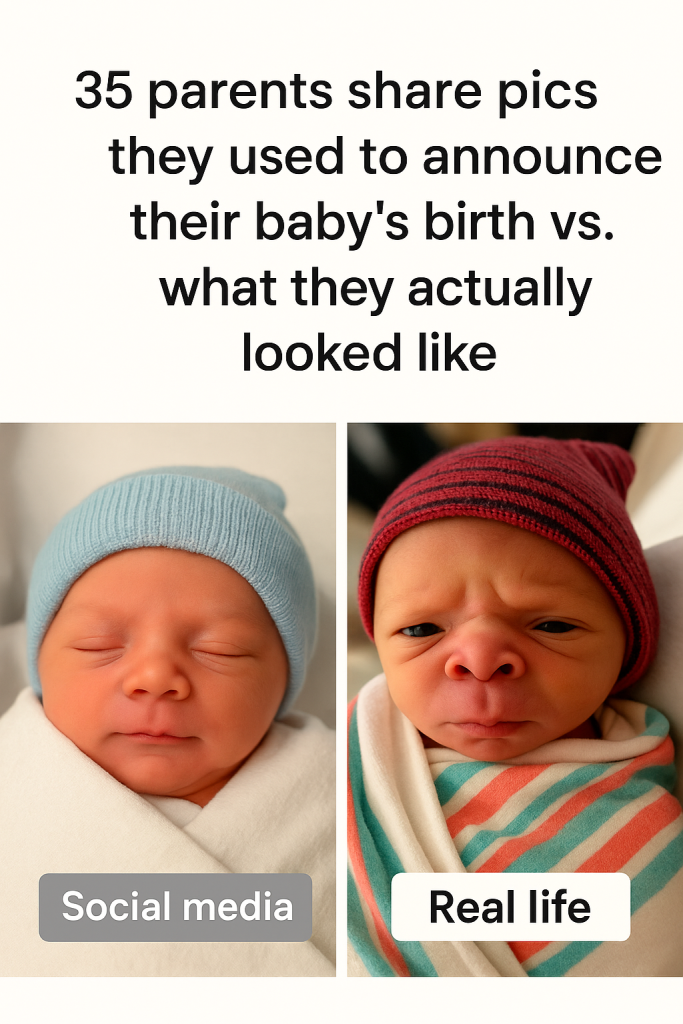In an endearing and often humorous social media trend sweeping across platforms in 2024, 35 parents have shared side-by-side photos showcasing their carefully staged baby birth announcement pictures versus what their newborns actually looked like in real life. This growing viral phenomenon is resonating widely as it highlights the unpredictable and candid moments of new parenthood that often contrast sharply with the idealized images shared online.
Across Instagram, Twitter, and TikTok, parents are posting two contrasting images: one showcasing the perfectly posed, cherubic, and serene newborn photos used for announcements, and the other revealing the much less polished — yet entirely genuine — reality of their babies’ first moments. These honest snapshots paint a more relatable and humorous picture of childbirth and new parenting, capturing everything from yawns and scrunchy faces to sleepy eyes and unexpected expressions.
What sparked this trend? Many parents expressed that the pressure to create “picture perfect” baby announcement photos often glosses over the emotional and physical chaos of welcoming a newborn. By posting these before-and-after images, they aim to celebrate authenticity over artifice, offering a refreshing reminder that real-life baby moments are just as beautiful, if not more so, than highly curated social media content.
The trend began gaining traction early in 2024, quickly morphing into a viral hashtag movement. Hashtags such as #BabyAnnouncementVsReality and #RealNewbornPhotos have been used thousands of times, encouraging other new parents to join in and share their own comparisons. Many posts show adorable disparities — from babies sporting unexpected expressions like wide-open mouths caught mid-cry, tiny subjects swaddled messily rather than pristinely, or parents grinning exhaustedly looking far less posed than their announcement photos suggest.
Experts say this trend taps into a growing desire for vulnerability and authenticity online. The social media culture surrounding parenting often creates unrealistic expectations, and these honest reveals help normalize the less glamorous aspects of early parenthood. For many, this has fostered a sense of community and relief, proving that “imperfection” is universal and even beautiful.
One parent’s post, for example, featured a bright, angelic studio photo of their baby wrapped perfectly with matching props for the birth announcement, contrasted humorously by a candid snapshot of the newborn mid-yawn with tousled hair and slightly reddened skin. The caption read simply: “What I sent to family vs. what baby REALLY looked like 10 minutes later.” Responses flooded in with laughs, empathy, and similar anecdotes.
The impact of this trend extends beyond humor. Pediatricians and parenting counselors have praised the movement for encouraging parents to embrace real moments without feeling pressured to “perform” perfection for social media. Many new parents report feeling more confident sharing unfiltered newborn moments, fostering deeper connections with loved ones and followers alike.
As the trend continues to spread, it has also inspired creative use of photo collage apps and themed templates designed explicitly to highlight the charming contrasts between birth announcement photos and real newborn appearances. Some digital parenting communities have even hosted contests inviting followers to submit their funniest or most heartwarming before-and-after announcement comparisons.
In a social media landscape often dominated by polished imagery, the “35 parents share birth announcement vs. real life” posts offer a heartwarming and humorous reminder: every baby’s journey into the world is unique, beautiful, and authentically imperfect. For new parents navigating this life-changing experience, these shared moments provide a comforting sense of solidarity and joy—proof that when it comes to welcoming new life, reality truly is better than any picture-perfect expectation.



